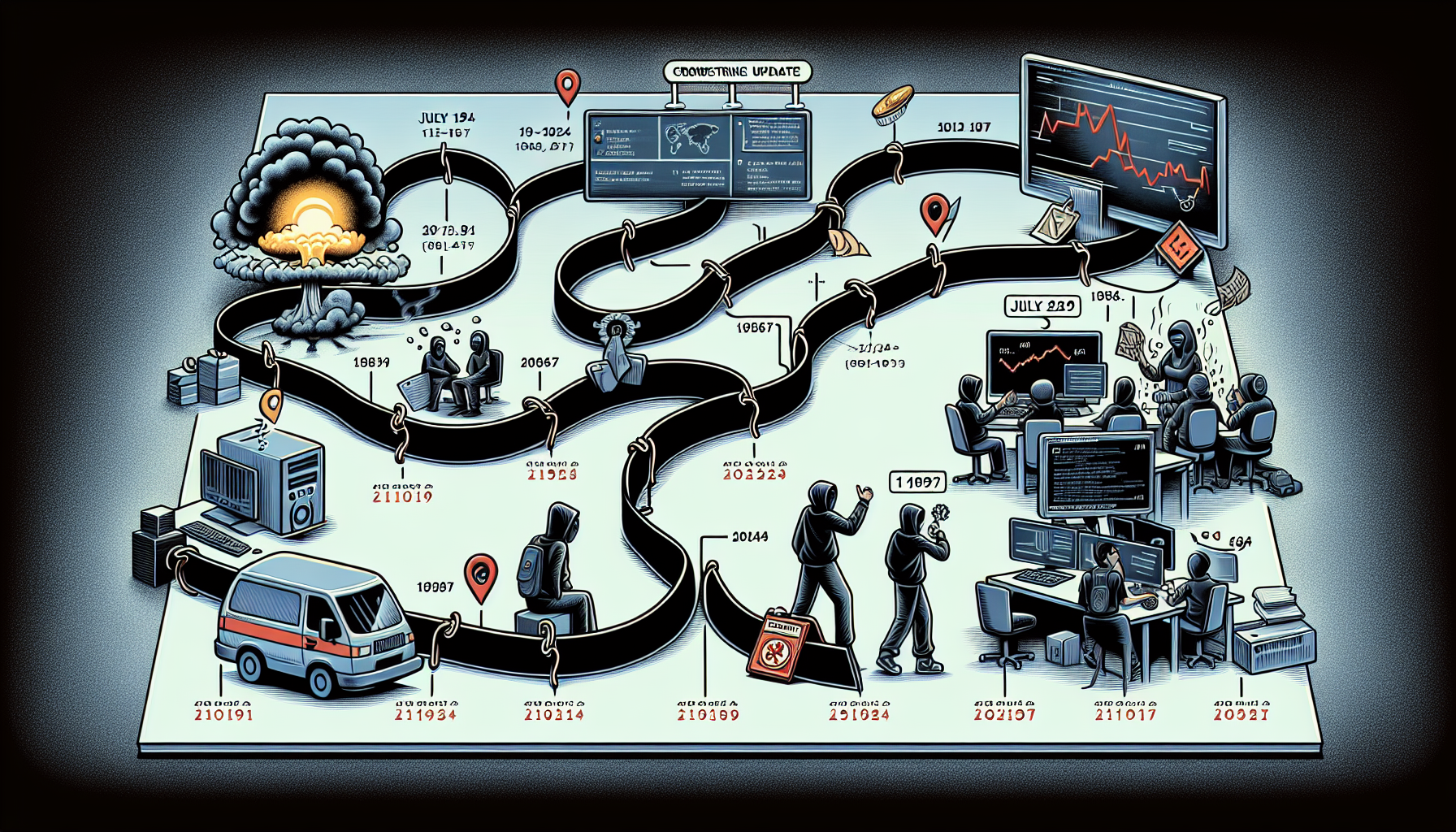On July 19, 2024, a CrowdStrike update caused a global IT outage, impacting millions of Windows devices. In this article on ‘crowdstrike microsoft outage and what we learned as CISOs,’ we explore the event’s specifics and discuss key lessons for IT leaders. Understanding the root cause and response strategies will guide future cybersecurity practices.
Key Takeaways
-
On July 19, 2024, a faulty CrowdStrike sensor configuration update caused a global IT outage affecting approximately 8.5 million Windows devices, with widespread system crashes across multiple industries.
-
The incident led to significant disruptions in essential services such as air travel, emergency services, and hospitals, highlighting the critical need for robust business continuity plans and thorough testing of software updates before deployment.
-
In response to the crisis, CrowdStrike and Microsoft collaborated to provide remediation tools and clear communication to affected customers, demonstrating the importance of swift recovery efforts and transparent communication during IT disruptions.
The CrowdStrike Update Incident
On July 19, 2024, the cybersecurity world was shaken by a global IT outage caused by a faulty sensor configuration update released by CrowdStrike for Windows systems. This silent update, pushed out to CrowdStrike’s Falcon agent, contained a critical logic error that led to widespread system crashes, including the notorious system crash and blue screen of death (BSOD) errors. A misconfigured update from CrowdStrike was identified as the root cause of the incident, disrupting approximately 8.5 million Windows devices worldwide.
The impact was immediate and far-reaching. Systems running Falcon sensor for Windows version 7.11 or higher were particularly affected, leading to chaos across numerous industries. The faulty CrowdStrike update triggered a cascade of system failures, highlighting the vulnerabilities inherent in our reliance on automated updates and the potential for a single misstep to cause a global IT outage.
As the dust settled, it became clear that this incident was not a result of a cyberattack but rather a preventable error within CrowdStrike’s update process. The incident underscored the need for rigorous testing and validation of updates before deployment, a lesson resonating throughout the cybersecurity community.
Immediate Impact on Businesses
The fallout from the faulty CrowdStrike update was felt across a wide array of sectors, causing widespread disruptions to essential services. Some of the impacts included:
-
Air travel came to a standstill as flights were grounded, leaving passengers stranded and causing significant economic losses.
-
Emergency services, including 911 lines, were disrupted, jeopardizing public safety and leaving operators unable to respond to critical situations.
-
In hospitals, operations were significantly hindered, with surgeries and other essential medical services being canceled.
Retailers were forced to close their doors for the day, and financial transactions were stalled, affecting everything from stock trading to everyday banking activities. The incident served as a stark reminder of how interconnected and reliant our modern enterprises are on IT systems. Businesses scrambled to recover, seeking ways to mitigate the impact and restore normalcy. This chaotic scenario emphasized the need for robust business continuity plans and preparation for unexpected occurrences.
Response from CrowdStrike and Microsoft
In the wake of the incident, both CrowdStrike and Microsoft mobilized swiftly to address the situation, providing remediation steps and assisting affected customers. CrowdStrike took immediate action by identifying the problematic content update and reverting the changes. At the same time, Microsoft worked alongside CrowdStrike to offer recovery tools and detailed instructions.
Importance of Testing Updates
Testing updates in isolated environments is essential to identify potential issues without affecting live systems. Organizations are advised to stage updates before deployment, allowing for thorough examination of their impact on system performance. Sandboxing environments are crucial for safely testing updates, helping to:
-
Identify bugs and vulnerabilities that could affect production systems
-
Ensure the updates do not cause any performance issues
-
Test the compatibility of the updates with existing systems and software
By testing updates in a sandboxing environment, organizations can minimize the risk of disruptions and ensure a smooth deployment process.
By implementing these practices, organizations can mitigate the risk of deploying faulty updates and ensure the stability of their IT infrastructure. Adopting a proactive approach to update management, as illustrated by the CrowdStrike incident, highlights the importance of rigorous testing and validation.
Future Directions for IT Management
In light of the CrowdStrike incident, CIOs & CISOs are re-evaluating their cloud strategies and focusing on building resilience within their IT environments. The subsequent sections will focus on future IT management considerations, including investments in data resilience, enhancing team collaboration, and ensuring regulatory compliance.
Timeline of Events
The CrowdStrike-induced Microsoft outage began on July 19, 2024, at 04:09 UTC. Here is a timeline of events:
-
CrowdStrike released a sensor configuration update that included a flawed channel file 291.
-
Affected systems started experiencing crashes and BSODs shortly after downloading the faulty update.
-
Disruptions peaked between 04:09 and 05:27 UTC.
-
By 05:27 UTC, CrowdStrike had identified the problem and reverted the faulty update.
This swift identification and retraction of the problematic update were crucial in mitigating further damage and beginning the recovery process. The sequence of events emphasizes the significance of a swift response and effective incident management in handling IT disruptions.
Case Studies of Affected Organizations
The outage caused by the faulty CrowdStrike update had significant repercussions for major services and organizations. Some of the impacts included:
-
Windows systems displaying Blue Screens of Death, rendering them unusable for critical periods
-
Major news services like Sky News being disrupted, affecting their ability to broadcast and report news in real-time
-
The aviation sector being particularly hard hit, with airlines such as United, Delta, and American Airlines facing significant flight disruptions
-
These disruptions grounding flights and stranding passengers, causing economic losses and logistical nightmares.
Tailoring approaches to fit each business’s unique requirements proved essential in mitigating the impact of the outage. For instance, government agencies and large enterprises had to deploy specialized teams to address the issue, while smaller businesses leveraged external IT support to recover. These case studies emphasize the need for flexible and adaptive IT strategies that can be promptly deployed to address specific needs and reduce downtime.
Effect on Stocks After The Incident
CrowdStrike erased all 2024 gains, down 30% since the incident. There has been a series of downgrades. For comparison, Solarwinds lost around 40% value after their event (you can learn more about the lessons learned from the Solarwinds hack here: https://www.cisoplatform.com/event/fireside-chat-lessons-learnt-from-the-solarwinds-attack). Everyone is looking at Crowdstrike to see how they will manage their customers and help them recover their systems.

Summary
The CrowdStrike-induced Microsoft outage of July 2024 serves as a reminder of the vulnerabilities in our interconnected IT systems. From the initial faulty sensor configuration update to the widespread disruptions and the collaborative recovery efforts, this incident highlights the critical importance of rigorous update testing, robust business continuity plans, and resilient IT management strategies. As we move forward, it is imperative for CIOs and IT leaders to prioritize data resilience, foster collaboration, and maintain regulatory compliance to safeguard against future disruptions. By learning from this incident, we can build stronger, more secure IT infrastructures capable of withstanding the challenges of an ever-evolving digital landscape.
Frequently Asked Questions
What caused the CrowdStrike-induced Microsoft outage?
The CrowdStrike-induced Microsoft outage was caused by a faulty sensor configuration update for Windows systems that resulted in widespread system crashes and blue screen errors.
Which sectors were most affected by the outage?
The outage most affected air travel, emergency services, hospital operations, and financial transactions. These sectors experienced severe impacts due to the outage.
How did CrowdStrike and Microsoft respond to the incident?
CrowdStrike and Microsoft collaborated to identify and address the issue by reverting the faulty update and providing recovery tools and instructions for affected customers.
What challenges were faced during the recovery process in cloud environments?
Recovery in cloud environments was complex, requiring manual interventions such as shutting down virtual servers and cloning disks. This highlights the need for robust cloud management practices.
What lessons can CIOs & CISOs learn from this incident?
CIOs can learn the importance of proactive measures, thorough testing of updates, robust business continuity plans, and diversified patching strategies to enhance their IT infrastructure's resilience. Being prepared for potential incidents is crucial for maintaining a reliable IT environment.




Comments